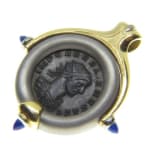Gold Pendant with Bronze Coin of Emperor Aurelian, 270 CE - 275 CE
Bronze, Gold, Lapis
FJ.6765
Further images
By the year 270 A.D., the Roman Empire simply was not what it once was. Large portions of the North and East were controlled by usurpers; barbarian raids were a...
By the year 270 A.D., the Roman Empire simply was not what it once was. Large portions of the North and East were controlled by usurpers; barbarian raids were a real threat on every border. Emperors were no longer selected for their aristocratic bloodlines; but the current situation demanded a leader with an iron hand. Lucius Domitius Aurelianus was such a man. Neither aristocratic nor Italian (few rulers of the preceding century had been either), Aurelian was first and foremost a soldier. Upon the death of Claudius II from 'plague' (most probably smallpox), Aurelian assumed the reigns of power and informed the Senate of his position. He then set about cleaning up the mess that was the Roman Empire. In five years, until he was assasinated in a plot concocted by his personal secretary, Aurelian made great strides in restoring Rome to a position of security, earning the self-adopted title restitutor orbis (“restorer of the world”).
On the obverse of this coin, the bust of the Emperor, wearing the laureate crown, is depicted draped and cuirassed. The reverse shows the god of the sun with captives. Here he is called Oriens, the rising sun, but other representations honor Sol, the solar disk. Aurelian promoted worship of the sun across the Empire and made the birthday of the sun the most important holiday on the Roman calendar. This special date, 25 December, was later adopted in Rome for Christian use. The stunning pendant complements the coin, elegantly presenting it without distracting from it. The decorative highlights in lapis lazuli reinforce the beauty and rarity of this piece. Overall, this pendant is so splendid not just because of the precious metals and ancient coin, but because of what it symbolizes: a link between the present and the past.
On the obverse of this coin, the bust of the Emperor, wearing the laureate crown, is depicted draped and cuirassed. The reverse shows the god of the sun with captives. Here he is called Oriens, the rising sun, but other representations honor Sol, the solar disk. Aurelian promoted worship of the sun across the Empire and made the birthday of the sun the most important holiday on the Roman calendar. This special date, 25 December, was later adopted in Rome for Christian use. The stunning pendant complements the coin, elegantly presenting it without distracting from it. The decorative highlights in lapis lazuli reinforce the beauty and rarity of this piece. Overall, this pendant is so splendid not just because of the precious metals and ancient coin, but because of what it symbolizes: a link between the present and the past.





